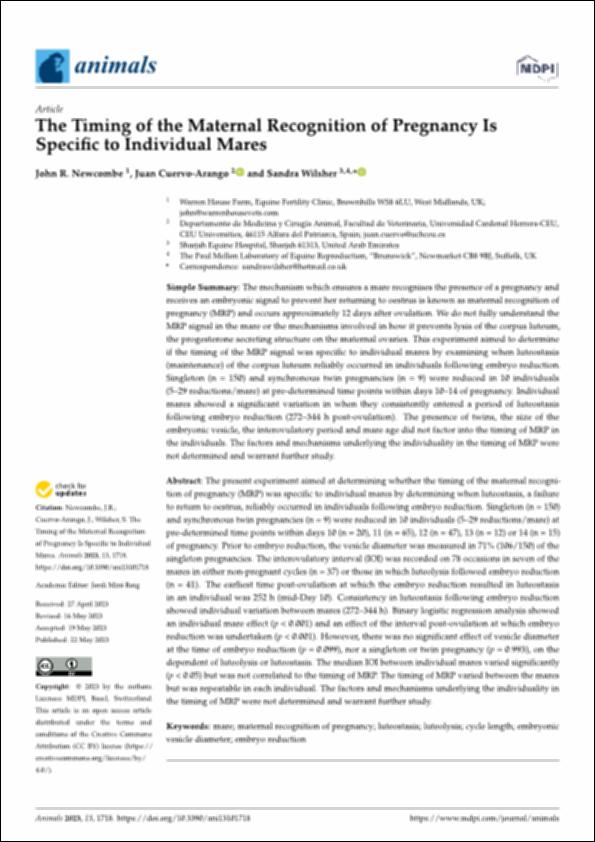Please use this identifier to cite or link to this item:
http://hdl.handle.net/10637/14494The timing of the maternal recognition of pregnancy is specific to individual mares
| Title: | The timing of the maternal recognition of pregnancy is specific to individual mares |
| Authors : | Newcombe, John R. Cuervo-Arango Lecina, Juan Wilsher, Sandra |
| Keywords: | Ovulación.; Ovulation.; Horses - Reproduction.; Caballos - Aparato genital.; Horses - Generative organs.; Estrus.; Gestación.; Pregnancy.; Caballos - Fecundidad.; Caballos - Reproducción.; Estro.; Horses - Fertility. |
| Publisher: | MDPI |
| Citation: | Newcombe, J.R., Cuervo-Arango, J. & Wilsher, S. (2023). The timing of the maternal recognition of pregnancy is specific to individual mares. Animals, vol. 13, i. 10 (22 may.), art. 1718. DOI: https://doi.org/10.3390/ani13101718 |
| Abstract: | The present experiment aimed at determining whether the timing of the maternal recognition of pregnancy (MRP) was specific to individual mares by determining when luteostasis, a failure to return to oestrus, reliably occurred in individuals following embryo reduction. Singleton (n = 150) and synchronous twin pregnancies (n = 9) were reduced in 10 individuals (5–29 reductions/mare) at pre-determined time points within days 10 (n = 20), 11 (n = 65), 12 (n = 47), 13 (n = 12) or 14 (n = 15) of pregnancy. Prior to embryo reduction, the vesicle diameter was measured in 71% (106/150) of the singleton pregnancies. The interovulatory interval (IOI) was recorded on 78 occasions in seven of the mares in either non-pregnant cycles (n = 37) or those in which luteolysis followed embryo reduction (n = 41). The earliest time post-ovulation at which the embryo reduction resulted in luteostasis in an individual was 252 h (mid-Day 10). Consistency in luteostasis following embryo reduction showed individual variation between mares (272–344 h). Binary logistic regression analysis showed an individual mare effect (p < 0.001) and an effect of the interval post-ovulation at which embryo reduction was undertaken (p < 0.001). However, there was no significant effect of vesicle diameter at the time of embryo reduction (p = 0.099), nor a singleton or twin pregnancy (p = 0.993), on the dependent of luteolysis or luteostasis. The median IOI between individual mares varied significantly (p < 0.05) but was not correlated to the timing of MRP. The timing of MRP varied between the mares but was repeatable in each individual. The factors and mechanisms underlying the individuality in the timing of MRP were not determined and warrant further study. |
| Description: | Este artículo se encuentra disponible en la siguiente URL: https://www.mdpi.com/2076-2615/13/10/1718 Este artículo de investigación pertenece al número especial "Equine Fertility: Embryo-Maternal Communication and Embryo Loss in the Mare". |
| URI: | http://hdl.handle.net/10637/14494 |
| Rights : | http://creativecommons.org/licenses/by/4.0/deed.es |
| ISSN: | 2076-2615 (Electrónico) |
| Language: | es |
| Issue Date: | 22-May-2023 |
| Center : | Universidad Cardenal Herrera-CEU |
| Appears in Collections: | Dpto. Medicina y Cirugía Animal |
Items in DSpace are protected by copyright, with all rights reserved, unless otherwise indicated.


